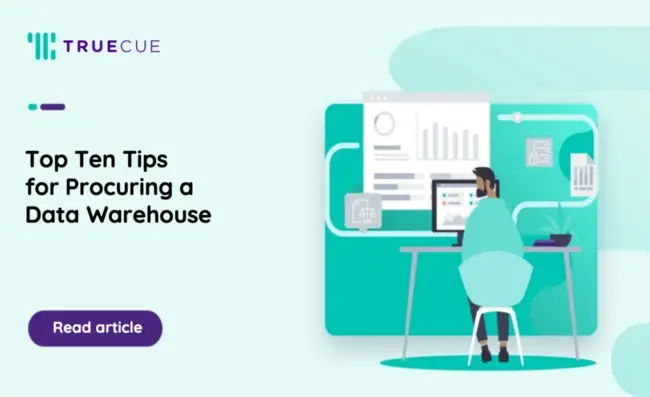
Many organisations look to external suppliers to enable them to implement a modern data warehouse.
If you’ve already read TrueCue's Cloud Data Warehouse Playbook for SMBs, then you’ll be fully aware of how fast-changing this technology landscape is, and what was the optimal approach last year is not necessarily the right approach this year.
Given the rise of Software-as-a-service (SAAS) and Platform-as-a-service (PAAS) solutions, such as the TrueCue Platform, displacing the do-it-yourself approach, here are some top tips from TrueCue's Richard Birtwistle to bear in mind when procuring a modern data warehouse to help you achieve the best outcome.
1. Plan on designing and building using agile methodology as much as you can. With value delivered incrementally, you can not only keep a control on the costs but also an eye on the benefits realisation. Often, as your stakeholders start to see the value in what is delivered, their use cases evolve along with the supporting benefits case, thereby unlocking significant incremental value.
2. Ensure that the procurement is business led, but with IT oversight. It is the business who will ultimately be the end users of the solution and the ones who are able to release the significant benefits.
3. Don’t procure based on day-rates. Yes, keep an eye on day rates, but focus more on obtaining a fixed price per unit of output – for example, per simple / medium / complex use case. A supplier with an innovative approach yet high day rates could deliver your outcomes at a fraction of the cost of a traditional approach. If you specify your use case category correctly, day rates should only feature in the delivery of the edge cases, and therefore shouldn’t weigh more than 10% in your cost evaluation. Furthermore, this enables you to keep control of your costs past the initial set of requirements.
4. Ensure that you include the BAU resource costs in your evaluation of suppliers. No business is ever static, and any solution requires BAU resource to support new requirements and upstream system changes. Different solutions require different levels of maintenance, and some of the skill sets are expensive to recruit.
5. Again, ensure that you include your cloud consumption costs in your evaluation of suppliers. An intelligent solution can optimise your consumption significantly, which can make a material difference in the total life costs between different bids.
6. Be open to all solution approaches – whether this be a managed build through to a fully managed service. With cloud technology evolving rapidly, today’s innovative managed build could be legacy within a couple of years.
7. Ensure you have simple and open RFI process prior to finalising the tender documentation – the industry is evolving rapidly, and you might not be aware of the latest available technologies and approaches.
8. Time cost / complexity – minimise your “deal breaker” requirements, as out-the-box solution that covers 90% of your requirements is significantly cheaper and faster to deliver than the 100%.
9. Ensure that your stakeholders have enough time to support the delivery of the data warehouse. You understand your business better than anyone else; even with the best-defined requirements, there will still be questions to be answered and designs to be reviewed. User Acceptance Testing (UAT) effort should not be underestimated.
10. Ensure you have captured the full scope of use cases prior to the tender – this will enable your suppliers to provide a more focused solution and accurate pricing.
If you’d like to discuss your data warehousing needs further, get in touch with TrueCue today.







Comments ( 0 )